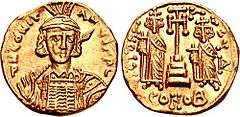Tiberius (son of Constans II)
| Tiberius | |
|---|---|
| Co-emperor of the Byzantine Empire | |
 A solidus with Constantine IV on the obverse and the reverse displaying Tiberius and his brother Heraclius | |
| Reign | 659–681 (alongside Constans II, Constantine IV and Heraclius) |
| Predecessor | Constans II |
| Successor | Constantine IV |
| Dynasty | Heraclian Dynasty |
| Father | Constans II |
| Mother | Fausta |
| Heraclian dynasty | |||
| Chronology | |||
| Heraclius | 610–641 | ||
| with Constantine III as co-emperor, 613–641 | |||
| Constantine III | 641 | ||
| with Heraklonas as co-emperor | |||
| Heraklonas | 641 | ||
| Constans II | 641–668 | ||
| with Constantine IV (654–668), Heraclius and Tiberius (659–668) as co-emperors | |||
| Constantine IV | 668–685 | ||
| with Heraclius and Tiberius (668–681), and Justinian II (681–685) as co-emperors | |||
| Justinian II | 685–695, 705–711 | ||
| with Tiberius as co-emperor, 706–711 | |||
| Succession | |||
| Preceded by Justinian dynasty and Phocas |
Followed by Twenty Years' Anarchy | ||
Tiberius (Greek: Τιβέριος, Tiberios) was Byzantine co-emperor from 659 to 681. He was the focus of a military revolt and was eventually dethroned by his brother, the senior emperor Constantine IV.
Life
Tiberius was the youngest son of Constans II. His mother was Fausta, daughter of the Patrician Valentinus.[1] Although his eldest brother Constantine IV had been raised to the rank of co-emperor in 654,[2] in 659, prior to his father’s departure for Italy, Tiberius was also elevated by Constans to the rank of co-emperor, alongside his older brother Heraclius.[3] In 663, Constans tried to have his sons join him in Sicily, but this provoked a popular uprising in Constantinople, and the brothers remained in the imperial capital.[3]
With Constans II’s death in 668, Constantine IV became the senior emperor.[4] He attempted to demote his brothers from the imperial position, but this provoked a military revolt in the Anatolic Theme.[5] The army marched to Chrysopolis, and sent a delegation across the straits of the Hellespont to Constantinople, demanding that the two brothers should remain co-emperors alongside Constantine IV.[5] They based their demand on the belief that, since Heaven was ruled by the Trinity, in the same way the empire should be governed by three Emperors.[6] Confronted by this situation, Constantine kept a close eye on his brothers, and sent across a trusted officer, Theodore, the captain of Koloneia, giving him the delicate task of praising the soldiers for their devotion and agreeing with their reasoning, with the objective of persuading them to return to their barracks in Anatolia.[7] He also invited the leaders of the rebellion to come over to Constantinople and consult with the Senate in order that they may begin the process of confirming the army’s wishes.[7] Happy with this apparently positive outcome, the army departed back into the interior of Anatolia, while the instigators of the movement entered the city.[7] With the military threat now gone, Constantine moved against the leaders of the revolt, captured them and had them hanged at Sycae.[6]
Throughout all this, Tiberius was kept under close observation, and it was only the fact that it appeared that he had no knowledge of the plot, nor did he express any desire to rule in tandem with Constantine, that saved his life, and he was allowed to retain his imperial title and status.[8] Yet his being the focus of a plot to curtail Constantine’s power meant that both he and his brother were now suspect in the senior emperor’s eyes; also, the emperor was keen to raise up his own son, the future Justinian II.[9] Sometime between 16 September and 21 December 681,[10] Constantine ordered the mutilation of his brothers by slitting their noses, and ordered that their images no longer appear on any coinage, and that their names be removed from all official documentation.[10]
After 681, Tiberius and his brother disappear from the historical record.
Sources
- Bury, J.B. (1889), A History of the Later Roman Empire from Arcadius to Irene, Vol. II, MacMillan & Co.
- Kazhdan, Alexander, ed. (1991), Oxford Dictionary of Byzantium, Oxford University Press, ISBN 978-0-19-504652-6
- Norwich, John Julius (1990), Byzantium: The Early Centuries, Penguin, ISBN 0-14-011447-5
- Canduci, Alexander (2010), Triumph & Tragedy: The Rise and Fall of Rome's Immortal Emperors, Pier 9, ISBN 978-1-74196-598-8
- Moore, R. Scott (1997). "Constantine IV (668–685 A.D.)". De Imperatoribus Romanis. Retrieved 18 November 2010.
- Dumbarton Oaks, Catalogue of the Byzantine Coins in the Dumbarton Oaks Collection, Vol. II, Part 2 (1968)
- Winkelmann, Friedhelm; Lilie, Ralph-Johannes, eds. (2001), Prosopographie der mittelbyzantinischen Zeit: I. Abteilung (641–867) - 5. Band: Theophylaktos (#8346) – az-Zubair (#8675), Anonymi (#10001–12149) (in German), Walter de Gruyter, ISBN 978-3-11-016675-0
References
- ↑ Kazhdan, pg. 496
- ↑ Kazhdan, pg. 500
- 1 2 Winkelmann & Lilie, pp. 47–48
- ↑ Moore, Constantine IV
- 1 2 Bury, pg. 308
- 1 2 Norwich, pg. 322
- 1 2 3 Bury, pg. 309
- ↑ Canduci, pg. 198
- ↑ Dionysius of Tel Mahre. From Robert Hoyland (2012). Theophilus of Edessa's Chronicle., pages 173-4 providing a synopsis between 1234 and Michael Syrus.
- 1 2 Dumbarton Oaks, pg. 513